Reading time: 1 minute
Climate change is having an increasingly noticeable impact on our environment and is leading to ever more frequent extreme weather events. At the same time, the construction industry contributes significantly to environmental pollution, be it through the consumption of resources and energy during the construction process or the life cycle emissions of the buildings through to the post-use phase with considerable amounts of waste that are not returned to the material cycle.
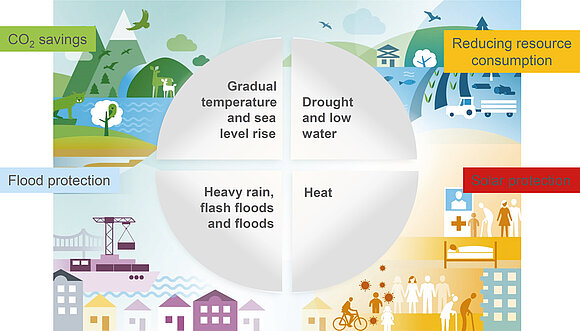
buildings, people and society (source: German Environment Agency 2022; https://www.umweltbundesamt.de/deutschland-im-klimawandel-risiken#undefined)
Sustainable construction products are a key component of the energy and resource transition. They are characterized by environmentally friendly manufacturing processes, low resource consumption and a long product life. They help to minimize the ecological footprint of buildings and contribute to achieving our climate targets. This will not stop climate change immediately, but if we do not act now, we will have to deal with even more severe climate extremes in the future, which will then be almost impossible to control.
Climate-resilient construction is therefore another important aspect. In view of the increasing frequency and intensity of extreme weather events such as heavy rain, heat waves, storms and hail, buildings must become more resistant to these natural extremes. This means that the effects of extreme weather events must be taken into account in the planning and construction of buildings in order to better protect our buildings and humanity from damage.
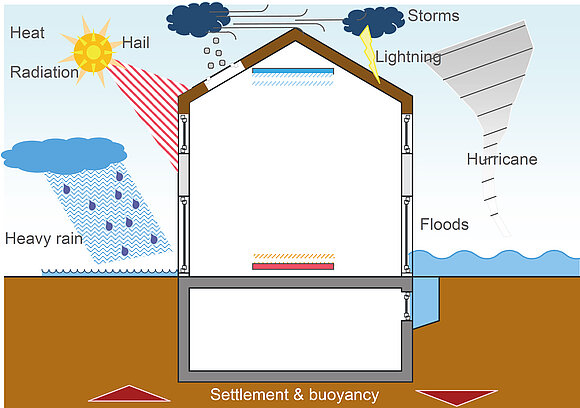
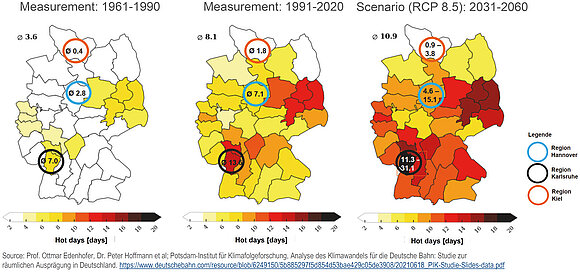
Climate-safe construction with sustainable building products is a crucial step towards a more sustainable future, improving climate adaptation by better protecting buildings and people from increasing weather extremes. This applies in particular to the overheating of buildings, where vulnerable groups such as children, the elderly or people with pre-existing conditions, where cardiovascular failure due to heat stress can even lead to death. There is therefore an urgent need to rethink the way we build and place sustainable and resilient principles at the heart of our construction activities.
How can sustainability and climate resilience be easily assessed?
The sustainability of products is currently described by a large number of labels and parameters, many of which are not transparent and often contribute more to consumer uncertainty than to a simple purchase recommendation. As yet, there are no suitable assessment systems for climate resilience for construction products. However, these are necessary so that planners, building owners and the trade can select suitable products. This is why ift Rosenheim has registered the EU warranty label "climate.proof.build" to enable simple and reliable product comparison on the basis of objective and transparent assessment criteria with regular certifications. The EU warranty label pursues the following objectives:
- Achieve a high level of credibility and acceptance in the market,
- Support sustainable manufacturers in sales,
- Obtain quick and easy information about product quality,
- Fair competitive conditions through transparent evaluation.
In addition, a weighted indicator is intended to promote product development, enabling the manufacturer to improve from year to year and achieve a higher "score".
The assessment criteria for the EU warranty label "climate.proof.build" are based on three pillars:
- Energy and CO2 efficiency
- Sustainability and environmental properties
- Climate resilience
While points one and two are aimed at slowing down climate change, the third pillar protects consumers from climate change (see fig. 4).
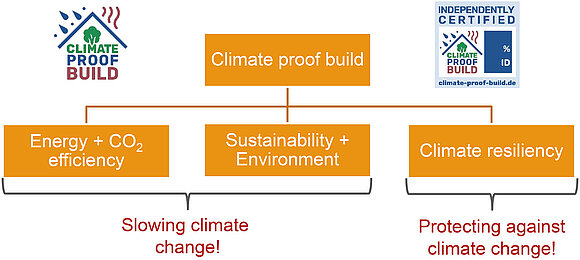
(source: ift Rosenheim)
The sustainability protective goals can be achieved on the product side through energy and resource efficiency, durability and good reparability as well as easy recyclability. Windows, doors and facades have already achieved a very high level of energy efficiency. It is already possible today to manufacture transparent building elements that capture more solar energy during the heating period (October to April) than is lost through transmission. Even in the summer months, buildings can in most cases be kept cool with effective, adaptive solar shading and night-time cooling by means of intensive window ventilation, or the energy consumption of technical cooling, which is sometimes necessary, can be significantly reduced.

However, a sustainable product also requires sustainable production. The product is only sustainable and has a low ecological footprint if it is manufactured efficiently using sustainable energy through the efficient use of materials, low emissions and recycling-friendly production processes. Socio-cultural aspects must also be taken into account during production. The greater the proportion of renewable or recycled raw materials used in production, the less gray energy is stored in the product.
The third pillar of the warranty label "climate.proof.build" is the plus through climate resilience. As a basic requirement, windows and facades must always have adaptive solar shading and protection against heavy rain, for example. If necessary, it must be possible for the product families to be upgraded to provide protection against floods, hurricanes or hail.
The purpose of the EU warranty label "climate.proof.build" is to increase the visibility of climate resilience and sustainability and to give end consumers the certainty that they are receiving sustainable, resilient and therefore future-proof products.
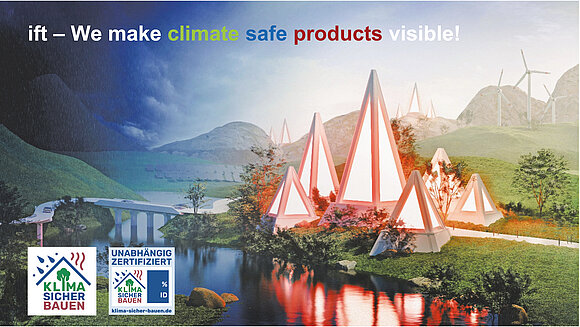
![[Translate to English:] [Translate to English:]](/fileadmin/_processed_/4/4/csm_KSB_Keyvisual_RGB_d231823baa.jpg)

